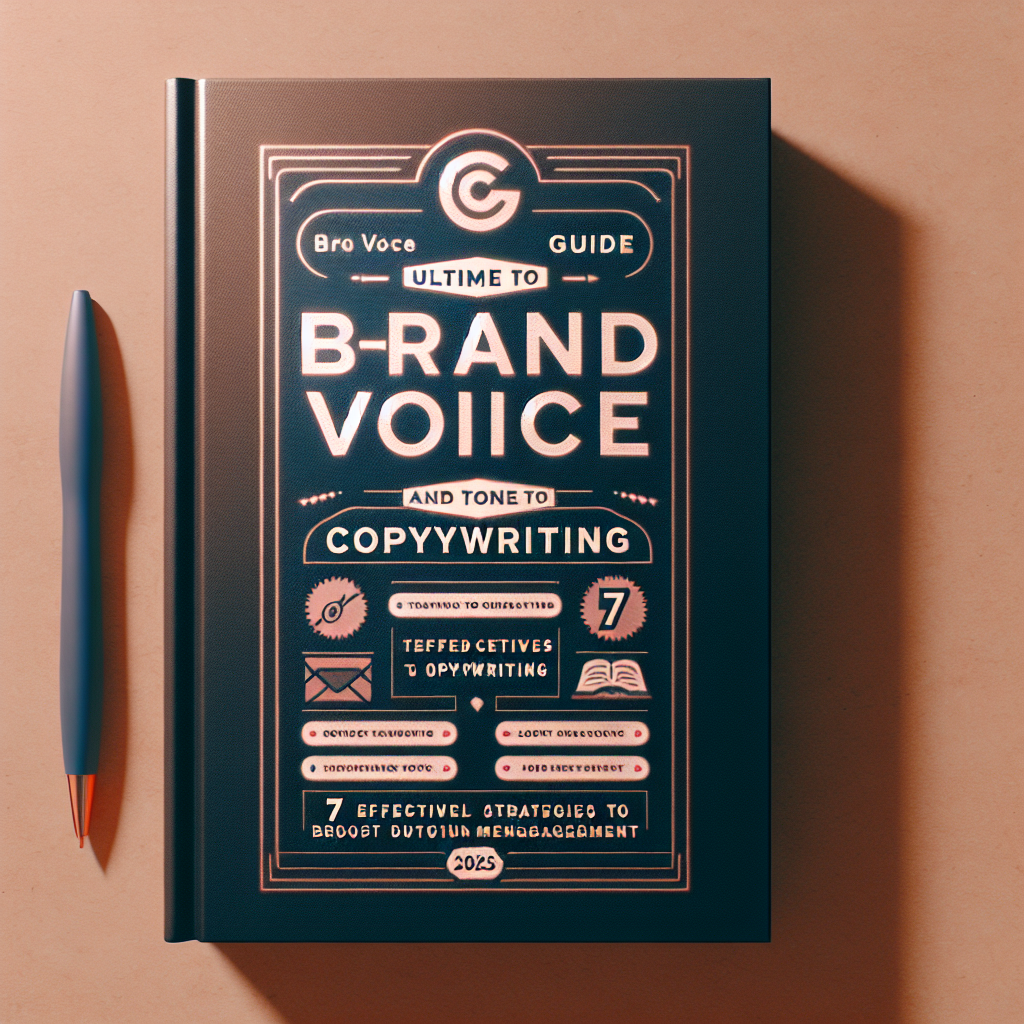The Ultimate Guide to brand voice and tone in copywriting (2025) | 7 Effective Strategies to Boost Engagement
1. Understanding the Basics of Brand Voice and Tone in Copywriting
What Is Brand Voice?
Brand voice refers to the consistent personality and style that a brand conveys across all communication channels. It encompasses the language, style, and the emotional inflection that aligns with the brand’s core values. For example, Nike’s voice is inspiring, energetic, and motivational, which resonates strongly with athletes and sports enthusiasts.
In 2025, understanding the nuances of your brand voice is more critical than ever. Data shows that brands with a recognizable voice enjoy 20% higher customer loyalty. Therefore, establishing a clear brand voice forms the foundation of effective copywriting that engages audiences and builds trust.
What Is Tone in Copywriting?
While brand voice is the personality, the tone is how that personality adapts to different contexts. Tone shifts depending on the message, audience, and platform. For instance, a playful tone might be suitable for social media but not for a formal annual report.
Effective copywriters learn to adjust tone while maintaining consistency with the brand voice. This balance ensures authenticity without sounding disconnected or inconsistent, especially in 2025, where audience expectations are more nuanced than ever.
Why Both Matter
Combining brand voice and tone effectively helps in creating memorable and relatable content. It enables brands to connect emotionally, influence perceptions, and foster brand loyalty. For example, brands like Apple maintain a sleek, innovative voice, but their tone adapts to the contextâfriendly in customer service, inspiring in advertising.
By mastering both, your copy can rise above the noise and create meaningful engagement, ultimately boosting your marketing ROI.
2. Conducting Effective Brand Voice and Tone Audits
Why Audits Are Essential
Regularly auditing your brand voice and tone helps ensure consistency across all channels. In 2025, consumer data indicates that inconsistent messaging can reduce engagement by up to 35%. Audits reveal gaps, misalignments, and areas for development.
Effective audits involve reviewing previous content, customer interactions, and competitor messaging. This holistic view helps refine your brand personality and keeps your messaging relevant and cohesive.
Steps to Conduct a Successful Audit
Start by collecting all content: emails, social posts, website copy, and advertising materials. Analyze these for tone consistency, language style, and emotional resonance.
Next, gather feedback from stakeholders and your target audience. Use surveys and focus groups to understand if your message aligns with their expectations. Incorporate data analytics to identify which messages perform best.
Leveraging Tools and Metrics
Use tools like Brandfolder, SEMrush, or specialized analytics to measure tone consistency and brand perception. Key metrics include engagement rates, sentiment analysis, and brand recognition scores.
Data-driven insights guide the refinement process, ensuring your brand voice and tone evolve with your audienceâs preferences in 2025.
3. Defining Your Brand Personality
Elements of a Strong Brand Personality
A compelling brand personality includes characteristics such as sincerity, excitement, competence, sophistication, and ruggedness. For example, Tesla’s personality blends innovation, sophistication, and sustainability, which shapes its messages in 2025.
Defining these elements helps guide your tone and voice, ensuring consistency across campaigns and platforms. It creates a unified brand image that resonates deeply with your target audience.
How to Develop Your Personality
Begin by identifying your core values and what differentiates your brand. Conduct competitor analysis to see how others position themselves and find opportunities for differentiation.
Ask questions like: If your brand were a person, what personality traits would it have? Create a brand persona that embodies these traits, and ensure your copywriting aligns with this persona each time you communicate.
Consistency Is Key
Once your brand personality is defined, embed it into your brand voice and tone guidelines. Regularly review content to maintain alignment and avoid drifting into inconsistent messaging, which can confuse or alienate your audience in 2025âs competitive landscape.
Use training sessions and onboarding to reinforce your brand’s personality across teams. This boosts internal consistency and enhances customer trust.
4. Developing Clear Brand Voice Guidelines
Creating Your Brand Voice Style Guide
A comprehensive style guide is the backbone of maintaining a consistent brand voice. It should outline preferred language, tone variations, vocabulary, and stylistic rules.
In 2025, these guidelines need to be adaptable to different channels, from social media to email marketing. Clear definitions prevent misinterpretation and ensure all team members speak with a unified voice.
Key Components of the Guide
- Voice characteristics: friendly, authoritative, innovative, etc.
- Tone variations per platform or audience segment
- Vocabulary and jargon preferences
- Sentence structure and style tips
- Examples of doâs and donâts
Training and Implementation
Ensure all content creators, marketers, and customer support teams are trained on these guidelines. Regular workshops and feedback sessions keep the messaging aligned.
Leverage tools like brand voice APIs or content management systems that embed style rules to streamline adherence.
5. Tailoring Tone for Different Platforms
Understanding Platform Nuances
Every platform demands a unique tone that complements its userâs expectations. In 2025, LinkedIn content might be more professional, while TikTok content could be casual and playful.
Adjusting tone without losing your brand voice in copywriting helps maximize engagement while maintaining authenticity.
Developing Platform-Specific Tone Strategies
Create a tone matrix aligning your core brand voice with platform-specific variations. For example, your company’s LinkedIn voice could be authoritative and insightful, while your Instagram tone might be friendly and conversational.
Regularly review platform analytics to see what resonates best, adjusting your tone accordingly.
Consistency Across Channels
While tones vary, maintaining core brand attributes is essential. This reinforces recognition and trust. Use templates and content frameworks that incorporate these tonal guidelines.
In 2025, AI tools can help automate tone adjustments based on platform parameters, ensuring consistency at scale.
2025. Leveraging AI to Enhance Brand Voice and Tone in Copywriting
The Rise of AI in Copywriting
Artificial Intelligence is transforming how brands craft their messages. In 2025, AI tools can analyze vast amounts of data to identify the most effective voice and tone for specific audiences and platforms.
By leveraging AI, brands can generate personalized, consistent copy that aligns perfectly with their desired voice and tone, reducing human error and increasing efficiency.
Tools and Best Practices
Using advanced AI solutions like GPT-based systems, you can craft drafts that reflect your brandâs personality. These models can adapt tone and style based on inputs to match your guidelines.
However, human oversight remains essential. Always review AI-generated content to ensure it authentically reflects your brand identity and is culturally appropriate in 2025.
Future Trends
Future developments point toward even more sophisticated AI capable of understanding emotional nuance and context at an unprecedented level. This will enable hyper-personalized and highly authentic copywriting.
Embracing AI not only boosts efficiency but also helps strengthen your brand voice and tone in copywriting, making your content more relevant and engaging than ever before in 2025.
Conclusion
In 2025, mastering the brand voice and tone in copywriting is vital for any business seeking to stand out in a crowded digital landscape. From defining a clear personality to leveraging cutting-edge AI, these strategies empower your brand to resonate deeply with audiences, increase engagement, and foster loyalty. Remember, consistency and authenticity are the keys to success. Keep refining your approach, stay aligned with your audienceâs evolving preferences, and watch your brand thrive in 2025 and beyond.
Frequently Asked Questions
1. Why is brand voice and tone in copywriting important?
It creates a recognizable personality for your brand that builds trust and emotional connection with your audience, enhancing engagement and loyalty.
2. How often should I review my brand voice and tone?
Conduct regular auditsâat least twice a yearâto ensure your messaging remains relevant and consistent, especially as your brand evolves.
3. Can AI really help with brand voice and tone in copywriting?
Yes, AI tools can assist in generating consistent messaging aligned with your guidelines, but human oversight is necessary to maintain authenticity.
4. How do I adapt tone for different channels?
Create a tone matrix that aligns your core brand voice with platform-specific nuances, ensuring consistency while catering to audience expectations.









